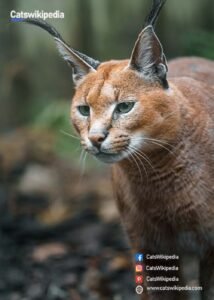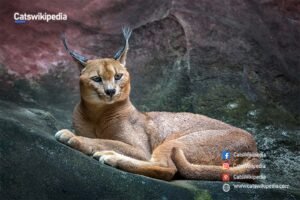African Caracal Cats
INTRODUCTION
Wild African Caracal cats that are medium in size are meant to be found in Central Asia, the Middle East, and Africa. The muscular body wears a burnished crimson coat that shines throughout, and its body is much stockier than that of its cousin serval. Dark thick black lines along the jaw are accentuated down the sides of the nose, framing their bottle-green eyes with an eyeliner halo that would make Elizabeth Taylor green with envy. As their hallmark, the Turkish word “Karrah-ulak/coulis” that translates roughly as “cat with black ears” inspired the name “caracal.” The unusual ears underline the impression of a proud and docile cat, fitting well with the overall appearance of Caracal.

The African Caracal cats is often called the desert lynx because of its evident similarities to the plethora of lynx species due to its tufted ears. But from the phylogenetic standpoint, caracals and lynxes are closely related. Its closest cousin is the African golden cat (Caracal aurata), inhabiting the rainforests of Central Africa. Caracal cats are all part of one lineage as the serval (Leptailurus serval). These differences, such as the subspecies classifications of the serval, are following a template one finds in other domestic kinds of mammals. They may alter with future genetic researches.
Although it is found in many different habitats, the shy nama and retiring African caracal prefers much drier regions with adequate cover. In the wetter regions, servals outcompete it to a great extent, and in the centrally forested areas of the continent, golden cats do the same. Like servals, caracals are generally considered nocturnal animals; however, they also may be active during the day, particularly when cooled.
Hunting Style of African Caracal Cats
Very flexible, caracals change their hunting methods depending on the prey and environment. While most hunts are ambush tactics, they are proficient climbers and runners. The Caracal is one of the faster species from the cats that belong to the smaller species, if not the fastest. Although they are not endurance runners, their speed of 80 km/h has been recorded, and their endurance is usually more than enough to chase after their favorite prey.
Long dogs kill small birds and rodents and eat them whole. Larger birds and prey are chosen following their having been bitten through the throat to mortally injure the animal. A caracal can cache large kills for later consumption. While not an exclusively water-independent species, they can meet most of their hydration needs from water sources in their food, and when provided with water, they drink very quickly.
Territorial and Sociality of Caracal
African Caracal Cats are solitary and territorial although little is known about their social or sexual activity. Territories greatly overlap, as their territories are demarcated through urine and scratching with claws. Similar to leopards, male territories appear to be dramatically larger than female territories, covering the territory of several females. The amount of available resources dictates the size of their territory and caracal density. Ideal ecosystems with abundant food and space have less territory and high population density.
Although their ear tufts and face markings, which include black stripes radiating from the nose that give them a ‘whiskered’ appearance, are deemed significant for intraspecific visual communication, caracals are vociferous. They growl, hiss, and purr, but also possess a twittering meow. In these instances, adult males and females mate only during the estrus of the female, which she announces by copious urination.

Early life of Caracal Cat
Despite the fact that African caracal cats breed all year round, the majority of litters are born at the beginning of the rainy season when there is an abundance of prey. The litter size ranges between one to six kittens. Female caracal will seek out a suitable location for a den in dense undergrowth or abandoned aardvark or porcupine tunnels. Although blind and defenseless at birth, the kittens multiply into cute, small, ferocious hunters. By about three to four weeks of age, they begin to attempt to start hunting in the den.
At six months, they are completely weaned, and between seven and ten months, they reach sexual maturity rather early. But they will only begin to breed when they successfully leave their mothers, most likely at 12 months.
Caracal conservation challenges
The general conservation status of caracals has been classified as “Least Concern” on the IUCN List, although this varies widely. Most populations in the Middle East and Asia face threats of habitat destruction due to human development, and there is strong evidence that caracals are close to extinction in North Africa. They frequently collide with cattle producers and are being killed in car accidents.
The informal group of medium-sized predators, the mesocarnivores/mesopredators, comprises African Caracal cats, foxes, and jackals, and the animals habitually reveal themselves as extremely tolerant of human invasion and adaptable. Such midrange carnivores flourish when the greater predators – by not being refractive to the human’s presence in view of their very massive size – are no longer a threat.
Sadly, this makes it much more likely to offend farmers. Even though research indicates that caracals prefer wild prey and domestic stock is only used as a complement it can still kill domestic stock.
According to this, caracals are considered “problem animals” and suffer from massive persecution in most Southern Africa regions, especially in Namibia and South Africa. Due to the fact that caracals are almost impossible to count, the impact of this struggle is only estimated or partially understood. The Cape Leopard Trust is currently undertaking research projects to assess the level of this problem and come up with ways to mitigate it.
It does seem incredible and paradoxical that some South African farmers have introduced caracals to farms to reduce stock losses. This would be through the natural antagonism between black-backed jackals, responsible for some of the lost stock, and caracals. The presence of one species will naturally limit the other, effectively balancing the system. Until now, the success of this system has never been properly measured.

Caracal as Pets
With their beautiful appearance and ease of taming, as well as a natural expression, caracals make great pets. For hundreds of years, African caracal cats were kept as pets in many regions of Asia, but exotic pet producers are booming today. Cats are not good pets. Any wild animal has instincts very near to the top, even without thousands of years of domestication. Most end up in a rescue center when the owner realizes how hard it is to handle them.
Wild Caracal sites
Drier southern Africa represents the sites with the greatest focus of observations for the African caracal cat, although they appear to range throughout the continent. They are seen more frequently because this region has less cover of foliage, and they are the top mesocarnivores. Superb sightings have been made from the Kgalagadi Transfrontier Park, Central Kalahari Game Reserve, and other Namibian parks.



